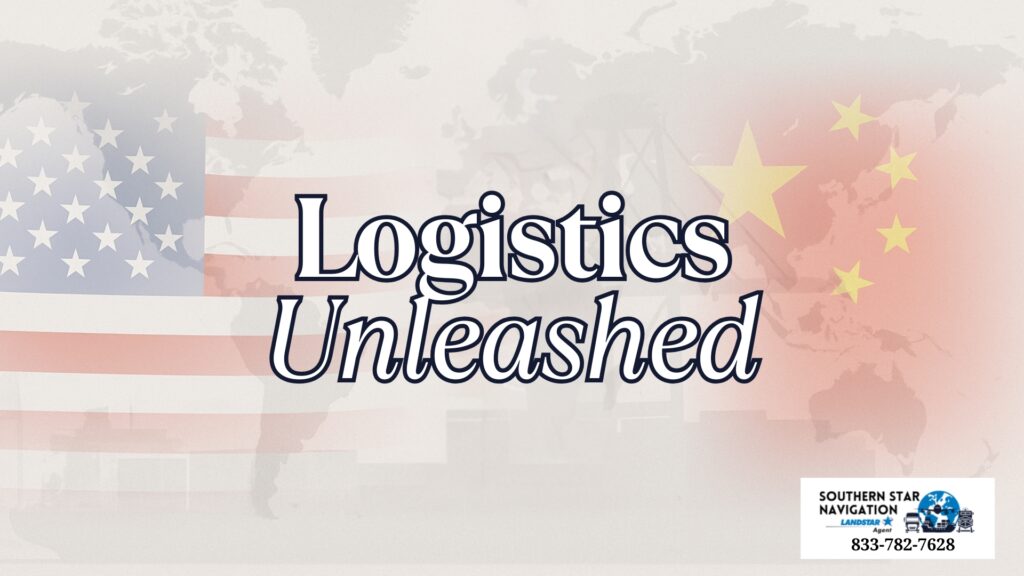
U.S.–China Tariff Reductions Now in Effect Under Executive Order
As of May 14, a new Executive Order officially put into motion the U.S.–China tariff agreement negotiated earlier this month. The deal rolls back 115% worth of recent tariff hikes from both countries and sets a 10% baseline tariff for goods flowing between them. The U.S. has suspended its 34% reciprocal tariff (originally imposed April 2) for 90 days, and China has paused many of its retaliatory tariffs, including the 34% surcharge it had placed on U.S. exports. However, key tariffs like Section 301, Section 232, and those tied to fentanyl enforcement and national security remain firmly in place.
With this order now active, importers should begin seeing changes in duty calculations and costs for affected shipments. It’s a temporary shift — the tariff suspensions are set to expire on August 12 — giving businesses a short window to reassess costs and adjust sourcing strategies. Both governments have agreed to continue high-level trade talks, with a goal of rebalancing access and strengthening protections for domestic manufacturing. This agreement also includes cooperation on combatting fentanyl precursors — a major focus of recent U.S. trade enforcement efforts.
At Southern Star Navigation, we’re already helping importers recalculate landed costs and plan shipments around this temporary tariff relief. If you’re unsure how the changes affect your goods, we can walk you through what’s stayed, what’s paused, and how to stay compliant. You can read the full Executive Order here.
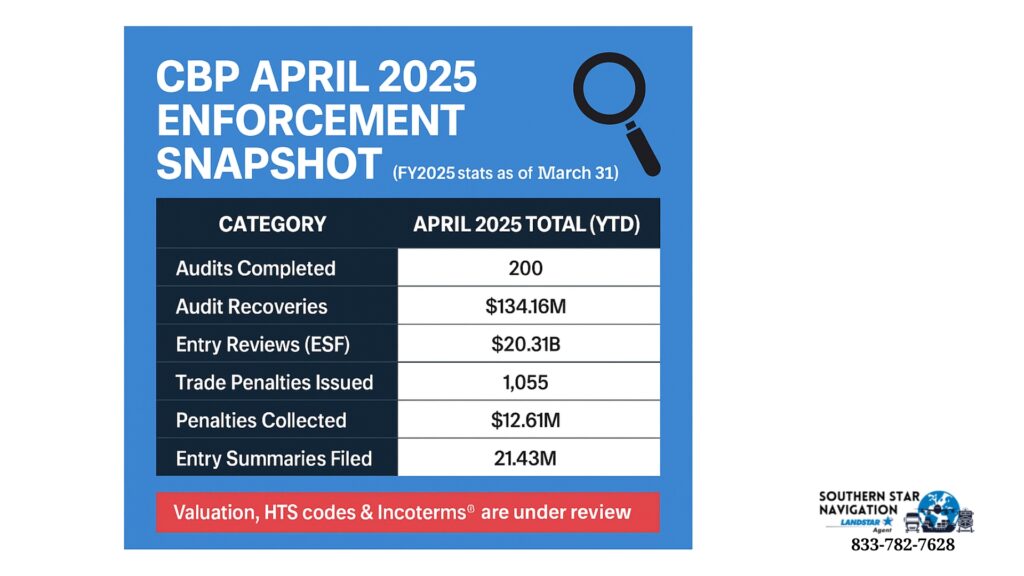
CBP Steps Up Trade Enforcement as Audits, Seizures, and Revenue Surge
April was a huge month for U.S. Customs and Border Protection — and importers should be paying attention. CBP completed 33 audits last month, uncovering $117 million in unpaid duties and fees. That’s in addition to the $16 billion in customs revenue collected during the month — a major contributor to the national budget surplus. This spike is tied directly to newly imposed tariffs, including the 145% total rate on some Chinese imports and broad-based increases of 10% to 25% on goods from countries like Mexico and Canada. CBP’s message is clear: enforcement is ramping up. Their top focus? Misclassified HTS codes, undervalued shipments, and documentation that doesn’t meet compliance standards — all red flags for audits and penalties.
CBP’s April report also shows a broader enforcement push. Officers seized over 758 pounds of fentanyl, flagged more than 140 shipments for suspected forced labor, and intercepted $502 million worth of counterfeit goods. Meanwhile, import volumes surged 9.1% as shippers raced to land goods ahead of looming tariff hikes — but analysts expect volumes to fall sharply in May. For importers, all signs point to one thing: compliance is not optional. If you need to revisit valuation, HTS codes, or how these new trade policies affect your cargo, now’s the time to do it. At Southern Star Navigation, we’re helping clients stay ahead of the curve — with guidance, updates, and audit support that keeps your freight moving and penalty-free. View the full CBP April 2025 update here.

CBP Clarifies Bonded Warehouse Entry Requirements — FIRMS Code Now Critical
CBP has issued an important reminder for importers using bonded warehouse entries (Entry Types 21 and 22): merchandise must be sent to an authorized bonded warehouse — not a container freight station, express consignment hub, or inspectional site. If the facility listed on your entry isn’t officially recognized as a bonded warehouse by CBP, your shipment will be denied deposit until the entry is corrected. In most cases, the issue comes down to the FIRMS code — either it’s missing or inaccurate. And if that happens, your cargo could be delayed, and CBP won’t cover the extra fees that result.
To avoid problems, importers should confirm that the warehouse listed on the entry has a valid FIRMS code by checking ACE Report TA-003 (Public FIRMS) before filing. Submitting incorrect facility info doesn’t just slow down clearance — it can also lead to penalties or liquidated damages, depending on the situation. You can view the full CBP bulletin here. At Southern Star Navigation, we’re helping our clients stay current on bonded warehouse requirements to prevent disruption and make sure everything goes smoothly — right from the start.
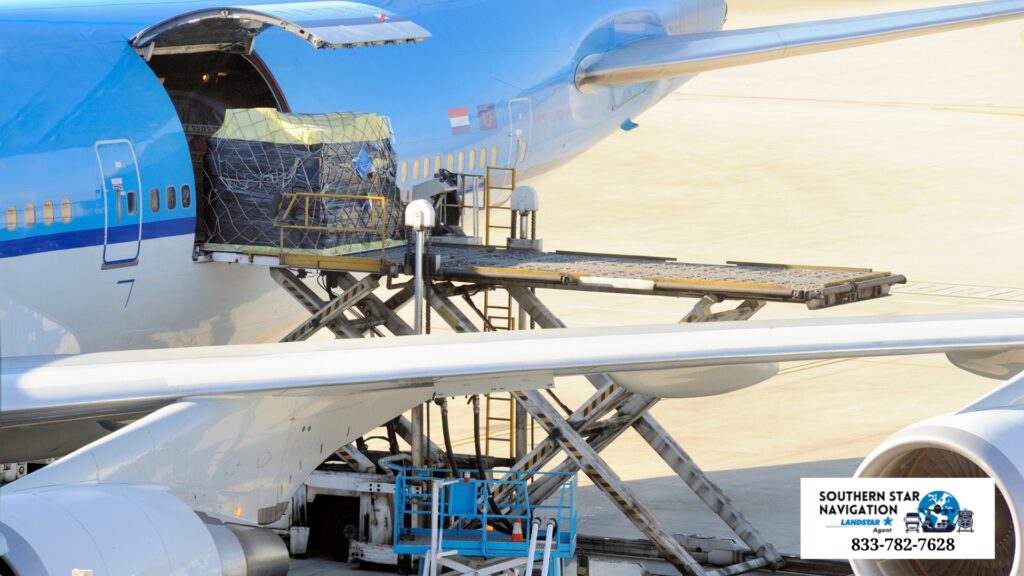
Transpacific Airfreight Picks Up as U.S.–China Tariff Pause Sparks Urgent Shipping
After weeks of tension and rising tariffs, the U.S. and China have hit the pause button on their trade war, and shippers are already reacting. With both countries agreeing to suspend most of the tariffs imposed since April 2 — and keep just a 10% base rate — air cargo volumes are beginning to rebound. E-commerce shipments, which had been hit hard by new de minimis duties, are also seeing some relief. The U.S. still applies a separate 20% tariff tied to the fentanyl crisis, but overall, the total rate on many Chinese imports is now down to 30%. That’s a big drop from the previous 125%, and it’s already shifting how and when companies are moving freight.
Air cargo rates and volumes are showing signs of life again after several weeks of decline. As capacity returns to the transpacific market, businesses are hurrying to move goods while the 90-day tariff suspension is in effect. Some companies are even reinstating previously canceled space agreements, while widebody freighter capacity between Asia and North America is climbing fast. At Southern Star Navigation, we’re helping clients act quickly — reviewing contracts, securing space, and adjusting shipping plans before the clock runs out. If you rely on airfreight from Asia, now is the time to review your strategy before demand ramps up and capacity tightens again.
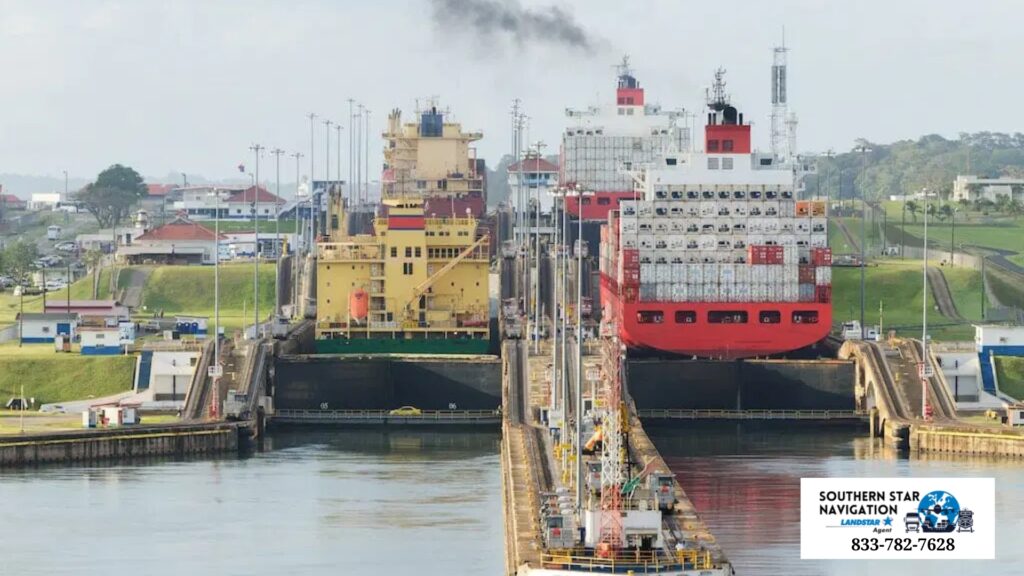
Panama Canal Pushes Back on U.S. Claims of Unfair Shipping Practices
The Panama Canal Authority (ACP) is firmly rejecting claims from the U.S. Federal Maritime Commission (FMC) that the canal may be treating American ships unfairly or allowing foreign influence to impact operations. In response to the FMC’s ongoing review of global maritime chokepoints, the ACP emphasized that the canal operates under a strict neutrality policy outlined in the 1977 treaty with the United States. They also clarified that 75% of all cargo moving through the canal is connected to the U.S., and no data shows any country — including China — receiving special treatment. While Hong Kong-based Hutchison runs two nearby terminals, the ACP made it clear these are separate from the canal itself, and there’s no requirement for ships to stop there.
With geopolitical tensions high and trade routes under global scrutiny, the ACP called on the FMC to stick to international law and avoid reacting to hypothetical risks or political rhetoric. They also pointed out that concerns over foreign-owned ports are speculative and that decisions about canal operations are made independently by the ACP, not influenced by Panama’s government or outside interests. For importers and exporters relying on the Panama Canal, this is a strong reminder that access remains open and fair — and Southern Star Navigation continues to monitor the situation to help our partners plan confidently.
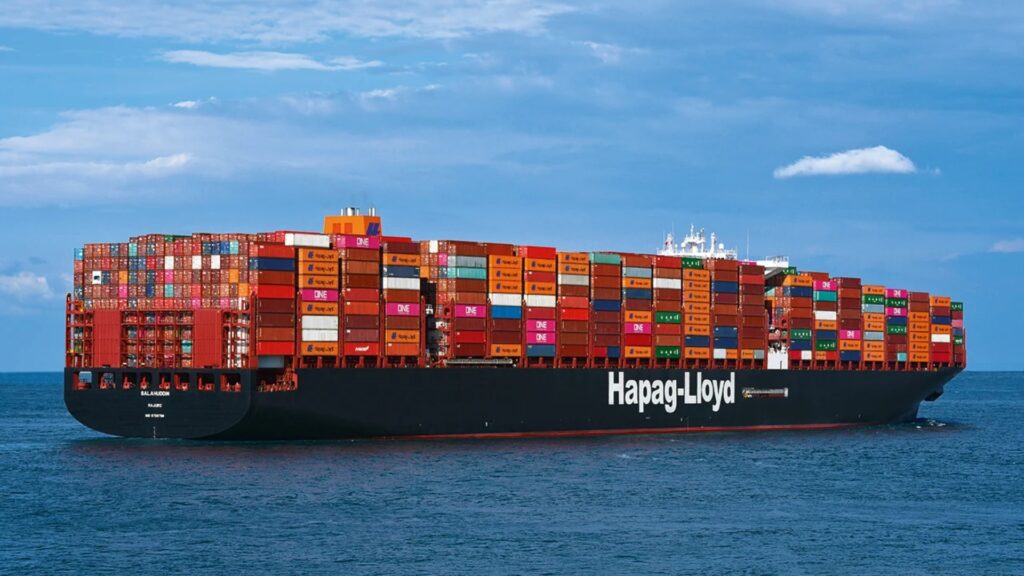
China–U.S. Ocean Bookings Surge as Tariff Pause Ignites Shipping Demand
Ocean freight bookings from China to the U.S. have surged over 50% this week as importers race to move cargo during the temporary 90-day pause on certain tariff increases. Under the new U.S.–China agreement, many items now fall under a reduced 30% tariff — but final rates still depend on how other tariffs, like Section 301, section 232 or IEEPA tariffs apply to the product. Carriers are rapidly redeploying larger vessels to keep up with demand, especially on key trans-Pacific lanes.
With this sudden spike in bookings, concerns are rising about potential congestion at U.S. ports. Some terminals are already stretched, and the return of bigger vessels could add more pressure. At Southern Star Navigation, we’re working closely with partners to help them understand which goods may benefit from the current rate shift, and how to time shipments to avoid disruptions.

U.S. and Saudi Arabia Announce Historic $600 Billion Investment Pact
The United States just locked in a game-changing economic partnership with Saudi Arabia. Under the newly announced agreement, Saudi Arabia has committed to investing $600 billion into U.S. industries over the next ten years. This massive investment package is designed to support American manufacturing, energy, infrastructure, and supply chain resilience. At a time when global competition is heating up, the deal sends a strong message that the U.S. is doubling down on domestic growth with help from international allies. From semiconductor expansion to electric vehicle infrastructure and AI development, the investment is expected to create hundreds of thousands of new jobs and generate long-term economic momentum across key sectors.
This agreement also includes provisions to enhance regional security, stabilize energy markets, and reduce supply chain vulnerabilities. It’s being praised as one of the most significant international investment commitments in U.S. history. For importers and exporters, this is more than just a headline—it’s a sign of shifting trade alliances and a signal to prepare for increased opportunity and competition. Southern Star Navigation is keeping a close eye on how this may impact global logistics flows and future shipping volumes between the U.S. and the Middle East. For more details, read the official White House Fact Sheet: President Trump Secures Historic $600 Billion Investment Commitment in Saudi Arabia.
Tariff Uncertainty May Slow West Coast Intermodal, Says Hub Group
Hub Group, one of the largest domestic intermodal carriers in the U.S., is preparing for a possible slowdown in West Coast volumes tied to U.S. tariffs on imports from China. The company says a noticeable dip in container traffic could occur between mid-May and the end of June. About 30% of Hub’s West Coast intermodal business is tied to goods coming from China, so shifting trade patterns are a growing concern. While scenarios vary, Hub expects a modest decline in volume through the second half of the year — likely without the typical peak season surcharges that hit many shippers last year. The biggest drop would come if Chinese imports stalled out or if consumer spending begins to weaken further.
Even though intermodal volumes rose 8% in Q1, Hub’s revenue per load dropped 12% due to shorter hauls and pricing pressure from a competitive bid environment. With truckload competition heating up and nearly 25% of Hub’s containers currently stacked and idle, the company is taking a cautious stance for the rest of 2025. At Southern Star Navigation, we’re monitoring these signals closely. Whether you’re moving full containers or planning inland logistics, understanding how trade policy affects intermodal pricing and equipment availability is key to keeping your freight on track.

Landstar Adapts with Strength as Truckload Market Sends Mixed Signals
The U.S. truckload market is evolving — and Landstar continues to navigate these shifts with resilience. While many large carriers are pulling back due to soft demand, Landstar is taking a smart, balanced approach. The latest Truckload Capacity Index (TCI) dropped to 74.9% in Q1, showing reduced capacity across the board, but this reflects strategic scaling — not a slowdown in capability. Landstar reduced its fleet size slightly, in line with seasonal trends, but continues to draw strong interest from new business capacity owners (BCOs). Even in a low-rate environment, Landstar’s model is proving durable, flexible, and attractive to independent owner-operators who value stability and long-term opportunity.
Meanwhile, new carrier authorities surged 48% in April, suggesting many still view trucking as a viable space. At the same time, industry analysts report growing spot market activity and pulled-forward imports, which could signal a shift ahead. At Southern Star Navigation, we’re helping clients plan ahead with confidence. As part of the Landstar network, we offer reliable capacity backed by one of the most trusted names in transportation. Whether you’re facing seasonal swings or navigating shifting freight flows, we’re here to deliver flexible, solutions-first support for your supply chain.

Marine insurance is crucial for businesses involved in shipping goods internationally. It provides comprehensive coverage that safeguards shipments against various risks and uncertainties during transit by sea, air, or land. This type of insurance is essential for ensuring that businesses can recover financial losses from potential damage or loss of cargo.
Importance of Marine Insurance:
- Protection Against Financial Loss: Covers the cost of goods lost or damaged during transit, ensuring businesses do not bear the financial burden alone.
- Risk Management: Helps manage and mitigate risks associated with transportation, including natural disasters, accidents, and piracy.
- Peace of Mind: Provides reassurance that goods are protected, allowing businesses to focus on operations without worrying about potential losses.
- Legal Compliance: Often a requirement in international trade contracts, ensuring that businesses meet legal and contractual obligations.
- Comprehensive Coverage: Includes protection against various risks such as theft, fire, and other perils specific to maritime transportation.
For more information, call Southern Star Navigation at 833.782.7628

